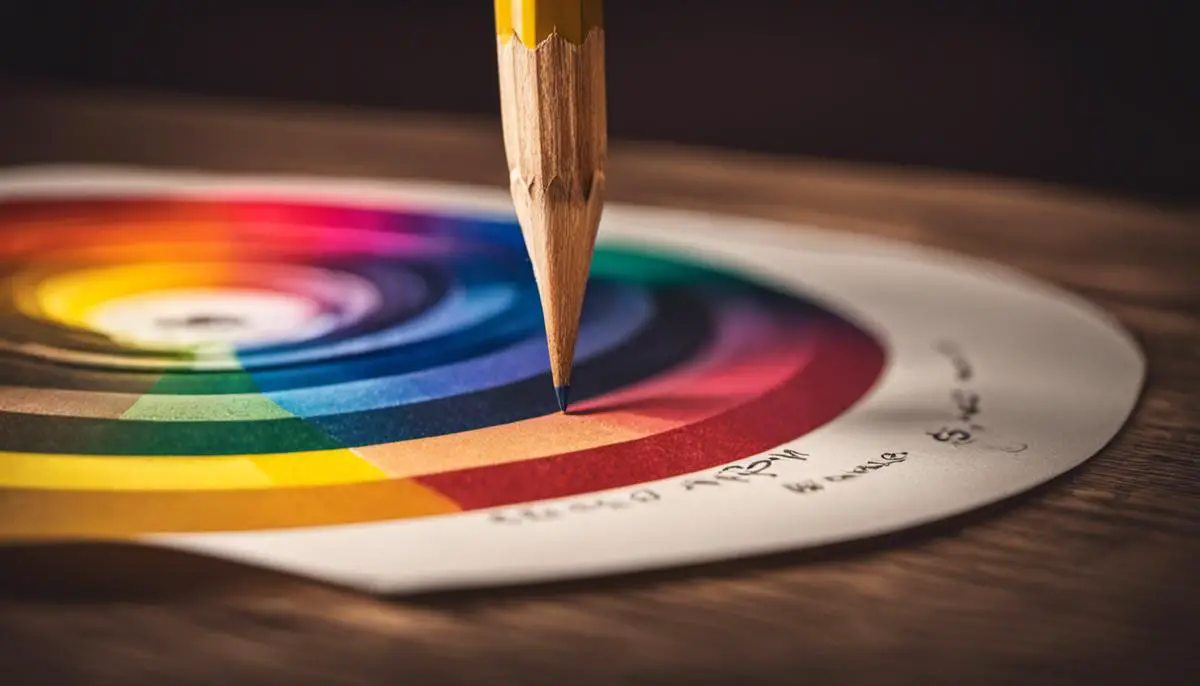Embarking on a journey into the world of graphic design is not only a fulfilling choice creatively, but it can also be a lucrative venture when leveraged correctly. With a market increasingly receptive to visually appealing content, it is important for the adept graphic designer to make the most of this demand in diverse ways.
This roadmap to earning a passive income as a graphic designer focuses on graphic design passive income strategies. You will explore how one can start by mastering the principles of design, developing a strong portfolio, creating and selling custom products, and harnessing the power of affiliate marketing and SEO to boost traffic and potential earnings.
Master the Principles of Graphic Design
Mastering the Principles of Graphic Design
To generate passive income as a graphic designer, first ensure that you have a strong understanding of the fundamental principles of graphic design. The four essential elements include color theory, typography, layout design, and branding.
To start with color theory, you need to comprehend how colors interact and influence one another, and how they can communicate specific feelings or messages. Using color combinations effectively in design can increase the impact of a project greatly.
Typography refers to the art of arranging type to make the text legible and appealing to the reader. Good understanding of fonts, sizes, spacing, and alignment can significantly improve the aesthetics of your design and make it more engaging.
Layout design is all about the arrangement of visual elements to achieve a balanced and effective composition. By understanding aspects like balance, contrast, and proportion, you may create an appealing and user-friendly design.
Branding is crucial for distinguishing businesses from their competitors, generating awareness, and driving customer loyalty. Your knowledge of creating impactful logos, choosing appropriate colors and fonts, and maintaining consistency will be vital in establishing a solid brand identity for clients.
Brush up Your Skills with Graphic Design Software
To execute your ideas and create compelling designs, master several graphic design software tools. The most popular of them are Adobe Photoshop, Illustrator, and InDesign.
Adobe Photoshop is great for tasks like photo editing, creating graphics and artwork, and website mockups. Learn how to navigate its layers, filters, tools, and techniques to create outstanding designs.
Adobe Illustrator is ideal for creating vector-based designs such as logos, drawings, typography, and illustrations. It offers precision and robust tools for graphic designers to craft intricate vector artworks.
Adobe InDesign is predominantly used for layout design projects like magazines, brochures, posters, and books. Its specification on layout and typography features makes it a useful tool for graphic designers.
Generating Passive Income
Once you master these, you can start producing designs that could generate passive income. One way is through selling your artwork or designs on platforms such as RedBubble, Society6, or Etsy. You could also sell your custom-made fonts, brushes, or templates on markets like Creative Market. Another way to earn money could be creating educational content such as how-to guides or tutorials about graphic design and selling them on platforms like Udemy, or you could also build a YouTube channel.
Remember, earning passive income is not an overnight phenomenon, it requires time and devoted effort. But with dedication and creativity, it’s absolutely achievable. Practice constantly to hone your skills and always stay updated with the latest graphic design trends. A well-crafted portfolio showcasing your design prowess to prospective clients or buyers is also essential in this process.

Develop a Strong Portfolio
Developing Your Skills
The first step towards building a strong portfolio is to develop and refine your graphic design skills. Enroll in online courses, attend workshops, and practice your craft regularly to keep your skills sharp. Familiarize yourself with the latest tools and software used in graphic design, as your expertise in using these will be vital when it comes to creating quality designs and attracting clients.
Deciding on the Type of Work for Your Portfolio
Before you start compiling your portfolio, decide on the type of work you want to showcase. This could be anything from logos and branding to illustrations, web design, or motion graphics. Make sure to pick work samples in line with the area(s) of graphic design that you want to focus on as a professional.
Assembling Your Portfolio
Once you have a clear idea of the type of design work you want to showcase, begin by selecting only the best examples of your work. Try to have a good mix of projects to show versatility but also include a specialization if you have one. For each project, include a brief description outlining the brief you received, your approach to solving the problem or task, the tools and techniques used, and any relevant results or feedback.
Polishing and Presenting Your Work
After you’ve selected the work you want to include in your portfolio, give every piece a polish. This doesn’t just mean improving the design components of your work, but also involves creating high-quality, professional-looking images for presentation. If necessary, use mockups to provide context and make your designs appear more realistic.
Setting Up Your Online Portfolio
Setting up an online portfolio is essential in the digital age. There are many sites like Behance, Dribbble, or even Instagram where graphic designers can showcase their work. Alternatively, you can create your own website which gives you more control over how your work is displayed. Ensure that your portfolio is easy to navigate, updated regularly, and that your contact information is clearly visible.
Promoting Your Portfolio
Promote your portfolio by sharing it on your social media channels, graphic design communities, and professional networks. Actively seek feedback and be open to making changes based on the feedback you receive.
Creating Your Own Products
Once you have an impressive portfolio and have gained some recognition, the next step would be to create your own products. This could mean designing your own line of prints, selling digital assets like stock illustrations, or even teaching online design courses. These avenues can provide a passive income stream and help you elevate your graphic design career.
Continually Updating Your Portfolio
One key thing to remember about a portfolio is that it should always be evolving. As you take on more projects and improve your skills, make sure to update your portfolio regularly to reflect your growth as a graphic designer. This not only shows potential clients your serious dedication to your profession, but also allows you to remain competitive in a fast-paced and dynamic industry.

Create and Sell Your Own Products
Explore Various Digital Marketplaces
There are numerous online platforms where you can display and sell your graphic design products. Some popular options include Creative Market, Etsy, Graphic River, and Shutterstock. These sites cater to an international market, giving you far-reaching exposure. Alternatively, you can also set up your own website or online store, which can give you full control over your brand, pricing, and marketing.
Finding In-Demand Products
Before you create your own design products, research what’s currently in demand. Identify popular trends and see how you can incorporate your unique artistic style into those trends. This could include logos, website templates, fonts, illustrations, or print designs. The key is to offer products that mix current trends and the uniqueness that only you can provide, creating a product that stands out in the market.
Create Your Design Products
Take your time to create high-quality, unique products. Use your graphic design skills to bring your ideas to life. This could involve using various software like Adobe Illustrator or Photoshop, depending on what kind of product you’re creating. Quality over quantity always stands true; it’s better to have a few top-notch, eye-catching designs than a heap of mediocre ones.
Pricing Your Products
Pricing your creations can seem daunting at first, but it’s an essential aspect of selling your work. Consider your time, effort, skill, and the value you’re providing to the customer while setting the price. You can look at similar products in the marketplace to get an idea of what customers are willing to pay.
Optimize Your Product Listings
When listing your product for sale, use detailed, clear descriptions and high-quality product images. Clearly showcase what the product is, its uses, unique features, and why someone might need or want it! SEO optimization is vital for online marketplaces, so use relevant keywords in your listing title, description, and tags.
Promote Your Products
Marketing your products is a significant part of earning passive income as a graphic designer. Share your products on your social media channels, create marketing campaigns, or offer promotional discounts to entice customers. This will help increase your brand visibility, attract customers, and potentially boost your sales!
Remember, creating a source of passive income requires ongoing effort upfront in creating and marketing your products. But once things are rolling, you could continue to earn income from these products with very little daily upkeep.

Learn About Affiliate Marketing and SEO
Understanding Affiliate Marketing
Affiliate marketing is a performance-based marketing strategy where you as a graphic designer can earn a commission by promoting other people’s (or company’s) products. You find a product you like, promote it to others, and earn a piece of the profit for each sale that you make. Therefore, if you have a blog or website, you can use it to host content that will help sell these products, and earn a share of the earnings from each sale that stems from your site.
Selecting an Affiliate Marketing Program
The first thing you need is an affiliate marketing program. Many companies, from Amazon to Adobe, have affiliate programs that you can join usually for free. You need to research to find affiliate programs that offer products that are relevant to your audience. After setting up your account, the next step is to get affiliate links which are special links assigned to you. These links track the referrals you make to the company’s product or website.
Promoting Affiliate Products
Once you have chosen products to promote and have your affiliate links, the next step is learning to effectively promote these products. As a graphic designer, you can do this by creating engaging visuals like banners, infographics, or pins for Pinterest and adding your affiliate links to these visuals. Moreover, you can also write product reviews or tutorials on your blog, including your affiliate link where possible.
Improving Visibility with SEO
SEO, or Search Engine Optimization, is a critical component in driving traffic to your site or blog. SEO involves various strategies to increase the visibility of your website or its content in search engine results. Effective SEO involves creating high-quality content that uses relevant keywords, optimizing your website’s loading speed, getting backlinks from other reputable sites, and optimizing your site for mobile viewers, among other things.
Importance of Keyword Research
Choosing the right keywords is a fundamental part of SEO. These are phrases that people are likely to search for when looking for the content that you offer. Using these keywords strategically throughout your website or blog improves the chances that your site will appear in search results when people search for those terms. Tools like Google’s Keyword Planner can help you identify the best keywords for your site.
Regular SEO Monitoring and Adjustment
Continuous SEO monitoring is necessary to ensure that your strategies are working. You should regularly check the analytics of your website or blog to see where your traffic is coming from, what keywords people are using to find your site, and other important information. With this data, you can make necessary adjustments to improve your SEO and increase traffic to your site.
Through affiliate marketing and effective SEO strategies, you can use your graphic design skills to generate a passive income. These methods, which include promoting affiliate products through engaging visuals and optimizing your site to appear in search engine results, can significantly increase your income as a graphic designer.

Equipped with a deep understanding of the principles of graphic design and the right tools at one’s disposal, the path to financial independence can be much more than just an aspiration. Upon successfully selling custom designer products and leveraging the power of affiliate marketing and SEO, every aspiring graphic designer has the potential to transform their passion into a continuous source of income. Remember, the key is persistent effort, creativity, adaptability, and an unwavering approach towards designing to keep up with evolving market trends.



